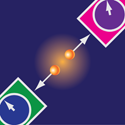When the quantum dog doesn’t bark
In a famous Sherlock Holmes tale, the fact that a dog did not bark allowed the fictional detective to solve a case. The absence of quantum events may also prove useful, as reported in Physical Review Letters by Tae-Gon Noh of the Electronics and Telecommunications Research Institute in Daejon, Korea. In quantum cryptography, remote parties (invariably named Alice and Bob) share a secret key, distributed over a quantum channel, which can be used to encrypt and decode messages between them. In conventional quantum key distribution, all of this is done via transmission of particles carrying secret information, and any attempt by an eavesdropper (the relentlessly malicious Eve) to snag the key will be thwarted thanks to the laws of quantum mechanics.
Noh proposes an alternative protocol based on “counterfactual” quantum communication in which a secret key can be distributed as a result of the mere possibility of particle transmission rather than an actual event. To achieve this, a single photon is sent into a Michelson interferometer, one arm of which is watched by Bob, while the other arm is examined by Alice. Bit values are encoded in photon polarizations, and Alice and Bob can set up a secret key by noting which photons are detected in which arms, including events in which photons do not even travel down the signal path that Bob is watching (the silent quantum dog). The author points out that this method can be implemented with existing optical technology and may foil Eve, who cannot benefit from photons that haven’t been transmitted. – David Voss





